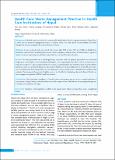Please use this identifier to cite or link to this item:
https://hdl.handle.net/20.500.14356/1615Full metadata record
| DC Field | Value | Language |
|---|---|---|
| dc.contributor.author | Joshi, Hari Datt | - |
| dc.contributor.author | Acharya, Trishna | - |
| dc.contributor.author | Dhakal, Purushottam | - |
| dc.contributor.author | Ayer, Rakesh | - |
| dc.contributor.author | Karki, Khem Bahadur | - |
| dc.contributor.author | Dhimal, Meghnath | - |
| dc.date.accessioned | 2023-05-16T09:44:19Z | - |
| dc.date.available | 2023-05-16T09:44:19Z | - |
| dc.date.issued | 2017 | - |
| dc.identifier.citation | JoshiH. D., AcharyaT., DhakalP., AyerR., KarkiK. B., & DhimalM. (2017). Health Care Waste Management Practice in Health Care Institutions of Nepal. Journal of Nepal Health Research Council, 15(1). https://doi.org/10.33314/jnhrc.v15i1.963 | en_US |
| dc.identifier.issn | Print ISSN: 1727-5482; Online ISSN: 1999-6217 | - |
| dc.identifier.uri | http://103.69.126.140:8080/handle/20.500.14356/1615 | - |
| dc.description | Original Article | en_US |
| dc.description.abstract | Abstract Background: Medical waste is considered as a major public health hazard. In a developing country like Nepal, there is much concern about the management practice of medical waste. This study aimed to assess Health Care Waste Management practice among Health Care Institutions in Nepal. Methods: A cross sectional study was carried out between July 2012 to June 2013 in 62 different Health Care Institutions, selected from stratified proportionate random sampling technique from all administrative regions of Nepal. A structured questionnaire and observation checklist were used for data collection. Results: The waste generation rate is found significantly correlated with bed capacity, patient flow rate and annual budget spent in the hospital. It is found significantly higher in Teaching hospital than other Health Care Institutions of Nepal. An average of 3.3 kg/day/patient of medical waste (2.0 kg/day/patient non-hazardous and 1.0 kg/day/patient hazardous waste) was generated during the study period. Further, it was found that most of the Health care wastes were not disinfected before transportation to waste disposal sites. Very limited number of Health Care Institutions had conducted Environmental Assessment. Similarly, some of the Health Care Institutions had not followed Health care waste management guideline 2009 of Nepal Government. Conclusions: We found poor compliance of medical waste management practice as per existing legislation of Government of Nepal. Hence, additional effort is needed for improvement of Health care waste management practice at Health Care Institutions of Nepal. Keywords: Hazardous waste; legislation; medical waste management; Nepal; non-hazardous waste; occupational health. | en_US |
| dc.language.iso | en | en_US |
| dc.publisher | Nepal Health Research Council | en_US |
| dc.relation.ispartofseries | Jan-April, 2017;963 | - |
| dc.subject | Hazardous waste | en_US |
| dc.subject | Legislation | en_US |
| dc.subject | Medical waste management | en_US |
| dc.subject | Nepal | en_US |
| dc.subject | Non-hazardous waste | en_US |
| dc.subject | Occupational health | en_US |
| dc.title | Health Care Waste Management Practice in Health Care Institutions of Nepal | en_US |
| dc.type | Journal Article | en_US |
| local.journal.category | Original Article | - |
| Appears in Collections: | Vol. 15 No. 1 Issue 35 Jan-Apr 2017 | |
Files in This Item:
| File | Description | Size | Format | |
|---|---|---|---|---|
| 963-Manuscript-1847-4-10-20170611.pdf | Fulltext Download | 331.16 kB | Adobe PDF |  View/Open |
Items in DSpace are protected by copyright, with all rights reserved, unless otherwise indicated.
